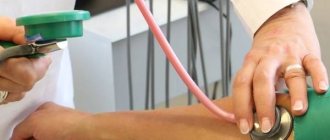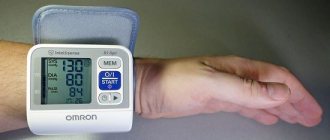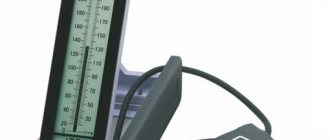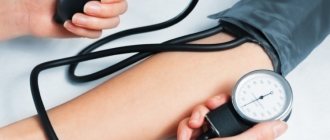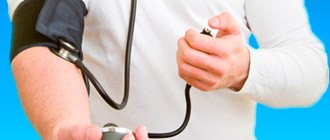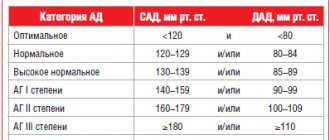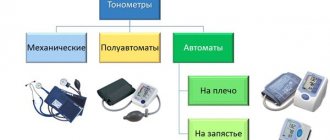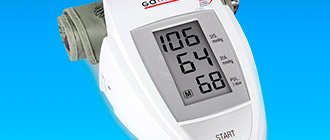To understand how to measure blood pressure at home, you need to understand the rules for performing the procedure. They are compiled in order to obtain the most accurate result. The rules for measuring blood pressure look like this:
- Before the procedure, you need to relax and preferably rest for half an hour, since you need to measure your blood pressure in a state of complete calm. Otherwise, the indicators will be overestimated.
- If blood pressure is measured in children, then before the procedure the child needs to explain its features and ask him to sit quietly.
- The methods for measuring pressure on the arms and legs are not particularly different. The cuff must be placed on the thigh, and pulse tones can be heard in the popliteal cavity. However, many cannot understand how to correctly measure the pressure on their legs due to the large difference in the indicators. This is due to the structure of the muscles and the characteristics of the blood circulation of the lower extremities, so it is better for beginners to determine blood pressure in their arms.
- Correct blood pressure measurement is carried out in a well-ventilated area at normal temperature. If it’s hot, the vessels will expand and the readings will be too low, but if it’s cold, they will narrow, and the result will be high.
With arterial hypertension, a person’s condition worsens. He experiences headaches, weakness, shortness of breath, chest pain and numbness in his limbs. If the problem occurs for the first time, then you need to consult a doctor. He should tell you how to correctly measure blood pressure and what this manipulation is. Gradually the patient will get used to this procedure and learn the algorithm of actions by heart.
If a patient has hypertension, then it is important to know not only how to measure blood pressure, but also how often it should be done.
It is advisable to do this at least 2 times a day and write down the results. It will be more accurate if blood pressure is measured at the same time 3 times in each arm with a break of 2 minutes.
Contraindications before the procedure
Before measuring your blood pressure, you need to find out what not to do an hour before the procedure:
- get physical activity;
- worry;
- smoke;
- There is;
- drink alcoholic beverages, as well as strong tea and coffee.
Blood pressure is measured several hours after taking antihypertensive drugs so as not to distort the results. For this reason, treatment of hypertension must be properly combined with constant blood pressure monitoring. This also includes any nasal or eye drops that could affect your readings.
If your condition worsens due to arterial hypertension, it is extremely important to know how to measure blood pressure at home, because you will have to do this almost every hour. All results must subsequently be shown to the doctor so that he can see the dynamics of the disease.
How can the doctor help?
When the difference in pressure in two arms exceeds 15 units, you need to consult a doctor and undergo a diagnostic examination. Regular blood pressure measurements are required; consultation with a specialist may be required.
Treatment in such situations is selected individually and may consist of:
- Taking medications with a blood thinning effect - this helps restore vascular patency and improve blood circulation;
- Exercise therapy to activate blood circulation;
- Physiotherapeutic procedures.
Sometimes conservative methods do not bring results. Then a surgical operation is prescribed to remove atherosclerotic plaques, blood clots, install stents on the vessels, and replace damaged arteries with prostheses.
The main thing to remember is that a timely visit to the doctor is the main condition for identifying the problem and the key to eliminating it.
Choosing a hand for measuring blood pressure
Many people are concerned about the question: on which hand the pressure is measured, because the accuracy of the final numbers may depend on this. Doctors advise taking measurements on both limbs, and then doing another circle. Before measuring the pressure 2 times, you need to wait 3-4 minutes. The results obtained should be recorded. They will help you choose which arm to measure the pressure on correctly, since from now on it will be possible to carry out the procedure on the limb on which the readings were too high.
Sometimes blood pressure readings in both limbs are the same. In this case, you can understand on which hand to measure the pressure based on other criteria, for example, whether a person is right-handed or left-handed.
If the right limb is used predominantly, then the measurement should be carried out on the left, and vice versa.
Conclusion
The tonometer is quite accurate and gives readings on a par with authorized (I would like to believe that they are attorneys) devices available in pharmacies and medical posts.
The price now with a coupon is OBVIOUSLY less than offline. Pros and cons
+ An automatic blood pressure monitor does not require any skills (every grandmother can figure it out) + The ability to store history for 2 users at once + a large number of records (99) + Voice acting. Plus with a caveat. An excellent option for people who are visually impaired but have basic knowledge of English numbers. - Voice acting in English only
Thank you for your attention. Health to you and your loved ones!
Difference in blood pressure
Sometimes the diagnosis of other pathologies depends on which hand to measure the pressure on. For example: the kidneys, liver, gastrointestinal tract, pancreas affect the right hemisphere, and the left hemisphere is affected by the lungs, upper limbs and heart. That is why different pressure in the hands has causes not only related to the cardiovascular system, but also to malfunctions of organs.
Finding out the algorithm for measuring blood pressure on different arms is especially important if the difference in indicators is 15 units or more. If such an increase has been observed for a long time, then the chance of complications increases. The patient immediately needs to be examined to find the cause of high blood pressure in the left or right arm.
The affected left or right side of the brain sometimes causes the following symptoms:
- worsening reaction;
- weakness and apathy;
- headaches and dizziness.
People who do not know which arm to measure blood pressure correctly often perform the procedure on one limb. Doctors advise people, especially those with hypertension, to first learn how to measure blood pressure, and then do it on both arms. In this case there should be no error.
Causes of high blood pressure in the left arm
High pressure in the left hand is especially noticeable in left-handed people who actively use the limb. The difference can reach 10-15 units. In people for whom the main right hand is dominant, the indicators on the left limb may also be slightly increased. Doctors explain the deviation as an anatomical feature. On the left arm, nutrition comes directly from the aorta, and on the right – from the brachiocephalic trunk, so the blood pressure level here is lower.
Causes of high blood pressure on the right arm
Blood pressure in the right arm may be slightly higher than the left if the person is right-handed and actively plays sports. Doctors explain this by saying that constant stress on the muscles of the shoulder girdle makes them larger and denser. The arteries passing through this area are compressed, causing blood pressure in the right arm to increase.
Cuff type and size
For home use, you can purchase a tonometer with a cuff that can be attached to the wrist or shoulder. The first option is relevant for athletes who need to frequently measure blood pressure during training, the elderly, and people with large arms. The sensor of the device is very sensitive, which leads to errors in the device during involuntary muscle contraction or during conversation. The hand should be kept leaning against the chest. This way the measurement results will be extremely accurate.
The most popular devices are those equipped with a shoulder cuff. These devices are quite accurate, but only if the cuff size is chosen correctly. For children, a conical or flat cuff is used, the coverage of which is 15-22 cm. For people of thin or average build, medium models are suitable - 22-32 cm. Products designed for 32-42 cm are relevant for large men and women. There is also a method for measuring pressure on the thigh. For these purposes, cuffs of 40-66 cm are produced. If the cuff is chosen incorrectly and is too large, the tonometer readings will be reduced. If it’s small, it’s overpriced. This will not make it possible to determine the real condition of a person.
Optimal hand position when measuring blood pressure
Situations in which there is a large difference in blood pressure
Often the problem is that a person does not know how to measure blood pressure correctly. Even if you don’t read the information on the Internet or consult a doctor, the box with each tonometer comes with instructions for measurement, but few people read it.
In more rare cases, the situation is aggravated due to the fact that the person does not understand which arm to measure blood pressure on and constantly does it on different limbs. Gradually, the difference in blood pressure begins to increase, but the patient will not know about it until visible symptoms occur.
Situations associated with pressure differences are as follows:
- One limb has normal pressure and the other has high pressure. In this case, the problem often lies in the development of VSD and anatomical abnormalities of the aorta and other arteries supplying the arms.
- High blood pressure on one limb and even higher on the other. This situation occurs due to the development of hypertension, VSD, as well as due to stress, overload and lack of sleep.
- Low pressure on one limb and high or normal pressure on the other. In this case, we are often talking about blockage of the artery or its compression.
The situations listed above do not arise immediately, but only after a long time. That is why it is important not only to understand on which arm the pressure should be measured, but also to periodically carry out the procedure on both limbs. In this case, the occurrence of many pathologies can be avoided.
Pressure measuring instruments
A home blood pressure monitor is a necessary medical device in every home. There are two options for tonometers:
- Mechanical devices are durable, but require an understanding of the operation of the device and experience in its use.
- Electronic tonometers - automatic or semi-automatic. They are easy to use, as they are equipped with a special display that instantly displays data after measurement, but their price exceeds the cost of mechanical ones.
The starting point for determining blood pressure is a consultation with a doctor. A specialist will determine the normal pressure for your body, show you how to measure it correctly and give the necessary recommendations for stabilization. It is important to understand that the normal pressure is determined individually for each patient.
Methods for determining blood pressure
Methods for measuring blood pressure vary, and much depends on the skill of the person performing the procedure. It will be difficult for a beginner to use a mechanical tonometer, so it is better for him to use a semi-automatic or electronic version of the device. The technology of application in this case will be different, but the measurement is much simpler.
There are the following methods for measuring pressure:
- auscultatory;
- palpable;
- oscillometric.
Auscultatory method for determining blood pressure
The auscultatory technique for measuring blood pressure is the most common and is used in most medical institutions. It requires a conventional mechanical tonometer with a bulb and a stethoscope. This method of measuring blood pressure was created at the beginning of the twentieth century by N. S. Korotkov, which is why it is often called the “Korotkoff measurement.”
You can find out how to correctly measure blood pressure using the Korotkov method by looking at the following algorithm of actions:
- Fix the cuff 3 cm from the elbow bend.
- The diaphragm of the stethoscope should fit snugly into the crook of your elbow. You cannot use it to compress this area, since it will not be possible to accurately measure the pressure due to the compression of the radial artery and the creation of additional compression.
- The bulb draws air into the cuff so that the end stop is 30 mm above the end of the pulsation.
- The valve on the bulb opens little by little to let the air out. The first pulse tones heard are the upper (systolic) pressure. The latter are the lower indicator (diastolic).
Doctors determine on which hand blood pressure can be measured based on the following criteria: whether a person is left-handed or right-handed. If a deviation from the norm is detected, the procedure is also performed on the other limb.
Palpation method for determining blood pressure
The methods for measuring pressure with a mechanical tonometer differ slightly from each other, so the palpation method is virtually identical to the auscultation method. The only difference is that there is no need to buy a stethoscope. Fingers are used instead. On which hand you need to measure the pressure is determined in the same way as in other cases.
Any person who knows auscultatory techniques can figure out how to correctly measure blood pressure using the palpation method. The algorithm of actions is actually the same, but instead of a stethoscope, the index and middle finger are applied. Otherwise, these methods of studying blood pressure are no different.
Appearance
The tonometer is made of white glossy plastic, it is quite durable and does not leave fingers on it. The display is normal for this type of technology, without backlight. There are only three buttons on the front side.
There is a sticker on the side with a barcode and production date. Fresh.:)
On the other side there is a compartment for batteries, it opens simply.
Powered by 2 AAA batteries
The cuff (strap) is quite thick and fits any wrist.
There is a drawing on the cuff that shows how to correctly position the device on your arm.
The cuff is fixed using the so-called “linden”
The end of the cuff, which remained free after putting the device on the arm, is bent and also fixed with “linden.” The linden is powerful and holds tightly.
The cuff is stitched
There is a speaker on the back of the case.
The device weighs 131 grams.
Device length 77.8 mm
Width 68.5 mm
Thickness at its thickest point 29.8 mm

